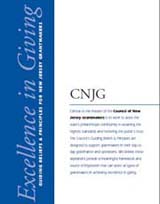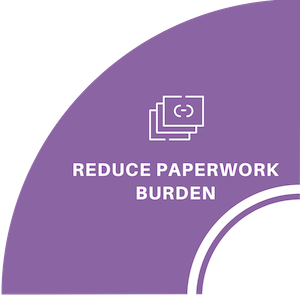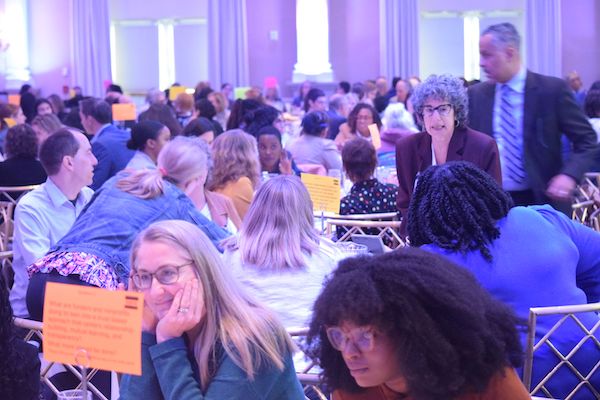Site Search
- resource provided by the Forum Network Knowledgebase.
Search Tip: Search with " " to find exact matches.
Right Size Applications; Simplify Reporting
Affirmation: Paperwork hinders us all.
Duplicative or complex proposal and reporting requirements divert time and resources for both nonprofits and philanthropy, needlessly burdens nonprofit partners and siphons scarce resources away from where they are most needed. Funders can lessen the burden on grantee partners by streamlining the application and reporting processes, especially for repeat grantee partners; decreasing the required data to only the most necessary for decision-making; taking on some of the burden of data collection by gathering data from central repositories such as Candid (formerly GuideStar) and the IRS; and retain and use data already collected from repeat grantees. Funders should require updated information such as annual budget, staffing, board member changes, etc., in their grant applications only when the nonprofit is the only source for this information. Collaborate with other local funders and agree to common GOS application questions and budget templates; streamline tools through technology and offer innovative ways for organizations to apply for and report out on grants; limit written requirements to information that is relevant to the request, and which moves the needle on critical social issues.
Activities
• Reduce rigidity and increase the flexibility of what nonprofits must submit for their applications in creative, egalitarian, and less burdensome ways.
• All funders right-size their application and report requirements relative to the grant amount.
• Shift from reports to conversations or other lower time-intensive means.
• Develop agreed-upon common questions for use across the philanthropy sector for general operating support grant applications.
• Explore the efficacy of using common applications for general operating support grants.
• Change site visits for compliance to goals of learning.
• Consider developing a central data repository for New Jersey nonprofits and funders, where applicants can submit and update basic information once a year, and funders can access the necessary information.
Outcomes
• 75% of funders begin to reduce the size of applications and reports relative to the size of the grant.
• 75% of funders shift from reports to conversations or other lower time-intensive means, like site visits geared to learning and relationship building.
• 50% of funders making general operating support grants accept creative, egalitarian, less burdensome applications including other funders proposals.
• Nonprofits have increased capacity to dedicate time to other activities and efforts.
How to Begin Doing Good Better on Reducing Burden
Learning opportunities
• For funders who do not right-size their applications, what are the barriers to reducing paperwork?
• Who is making the decisions about the application and reporting requirements, and how can they be reached to encourage change? How can we involve more board members of funders in this effort?
• For funders who require reports, determine what is “nice to have” vs. what is needed and used and consider eliminating the rest; what are expeditious ways to collect data including accepting other funders’ reports?
• Which funders who make multi-year grants require a full application for the first year and updates for subsequent years?
Pre-Work
• For funders who already report tailoring their applications, consider how to further simplify processes for grantees; share these practices with other colleagues in philanthropy.
• Learn how information is collected without burdening the applicant.
• Review and implement recommendations already provided by nonprofit networks and philanthropy-serving organizations for concrete examples such as centralized document repositories; allowing nonprofit partners to re-use other proposals and reports; holding check-in meetings in lieu of written reports; and other helpful practices.
• Seek promising practices of funders who use site visits as opportunities to build trust and understand the programs and organizations they support instead of as compliance reviews.
Notes:
See, for example, SMU DataArts (formerly the Cultural Data Project), https://culturaldata.org, a nationwide research and data repository for the arts and cultural community. DataArts serves as a collector and clearinghouse for a wide array of data, which funders can access instead of requiring nonprofits to provide it separately.
An overview on the self-dealing law, including definitions, common problem areas, exceptions, penalties, and resources.
FAQs for Benefit Survey
What is the New Jersey Foundation Benefits & Salary Summary Report?
Developed exclusively for CNJG members, the New Jersey Foundation Benefits & Salary Summary Report presents comprehensive benefits data specific to New Jersey's grantmaking community, alongside data from the Council on Foundations' annual salary survey. The last report, produced in 2017, can be found on our website.
Given increased scrutiny in the areas of compensation and benefits, the need to benchmark this information within the field has become even more important. The 2020 New Jersey Foundation Benefits & Salary Summary Report will make available critical information needed to determine fair compensation and benefits in the state across multiple organizational levels.
Who is eligible to participate in this survey?
To be eligible to participate in the survey, your organization must have at least one PAID (full-time or part-time) employee. The beginning of the survey will help respondents determine if they are eligible to participate. Even if you are NOT eligible to participate, please complete the first four questions of the survey. You will then be directed to the last page of the survey where you will be asked to submit your data. You do not need to be a CNJG member to participate. If you do participate, but are not a CNJG member, you will receive a copy of the report.
Where do I complete the survey?
The survey may be completed here: https://www.surveymonkey.com/r/2020CNJGBenefitsSurvey.
When does the survey need to be completed?
The deadline for submitting completed surveys is August 10, 2020.
I'm not the right person to complete this survey, can I email it to someone else to complete?
You may forward the email that contains the survey link to someone else in your organization. The recipient will be able to click on the survey link to access the survey.
How long will it take to complete the survey?
It is estimated that entering in the data should take around one hour (not including the time it will take to research your organization’s information). If you offer more benefits, it may take more time; if you offer less, the less time it will take to complete. Logic is built into the online survey, enabling you to skip questions or entire sections depending on what your organization offers. CNJG suggests looking through the questions first (available in PDF form) and compiling your answers to then enter in the data all at once online.
How do I submit our information to the survey?
CNJG developed the survey using SurveyMonkey, so that you may enter all of your data online. The prompts at the bottom of each page guide you as you enter your information.
Can I see all of the questions first?
Yes! The survey in its entirety can be found below. Feel free to use this document to gather your benefits data, and then enter the information all at once online at https://www.surveymonkey.com/r/2020CNJGBenefitsSurvey.
For which year/time period should I provide compensation and benefits data?
The Benefits Survey should be based on benefits data for the 2020 calendar year. Please complete the survey questions by indicating the benefits that your organization is currently offering to employees in 2020.
Help! The way that this question is structured is difficult (or impossible) for me to answer.
We understand organizations provide different kinds of benefits and have developed novel benefit packages. And, often, benefit packages differ within an organization. Please complete the survey questions by indicating the benefits that are offered to the majority of employees in your organization, and please use the comment boxes after some of the questions and at the end of the survey to further explain/clarify your responses. Please also note that, while many questions are required (indicated with an asterisk) some questions in the survey are optional and can be skipped.
Once I've started the survey, can I save it and complete it another time?
Yes! You may leave the survey at any time by clicking on "Exit this survey" on the upper right hand corner of the page. Note: if you have just entered a page of data, proceed to the next page before you exit, otherwise the data just entered for the current page will not be saved. To reopen the survey, click on the link in the survey email that was sent to you.
Once I've completed the survey, how do I submit my input?
To submit your input, go to the last page of the survey and click on "Submit Survey." Your input will automatically be submitted.
I clicked on "Submit Survey," but I wasn't finished completing the survey - what should I do?
To make changes in a survey that has already been submitted, please contact Craig Weinrich. It will be possible for you to make changes to your survey input until the survey is officially closed on August 10, 2020.
What topics will be covered?
The following topics will be covered in the survey:
• Survey Eligibility
• Organization Information
• Employment
• Leave Benefits
• Insurance Benefits
• Retirement
• Other Benefits
• Retiree Benefits
• Benefits Cost
Who do I contact if I have questions?
Should you have any questions or need additional information, please contact Craig Weinrich.
CNJG thanks you in advance for your time and assistance with this endeavor. The report that we create becomes an important tool for you to benchmark your salaries and benefits plans for the coming years, so the time and effort will be incredibly valuable to your organization and other CNJG members.
Two different CNJG members queried the CEO listserve on how/when/how to return to the office following the COVID-19 pandemic. CNJG staff compiled the answers from the responding members removing identifying information of the respondents.

This includes insights and tips related to board governance, legal compliance, grantee communications, fiscal responsibility, public disclosure, and many other key areas of foundation governance and operations. It is intended to serve as a practical resource to assist foundations in their grantmaking.
2025 CNJG Membership Renewal
Thank you for your membership investment with CNJG!
We continue using our contactless renewal process for the 2025 membership year. We no longer mail renewal notices. The “primary contact” for each member will receive the renewal notification by email in mid-October, 2024
“[CNJG has] done an amazing job of meeting people where they need to be in terms of providing additional resources and access to people in the know to help us navigate through very unchartered waters.”
-Margarethe Laurenzi, Maher Charitable Foundation
The dues investment for 2025 includes a Board-approved 3% increase. Members should base their 2025 dues on either:
1. Your 2024 giving or
2. An average of the past three years in giving (2022, 2023, 2024).
The chart of dues, based on your annual giving is below:
| Annual Giving Level | 2025 CNJG Dues |
| $ 0 to $ 100,000 | $ 770 |
| $ 100,001 to $ 250,000 | $ 925 |
| $ 250,001 to $ 500,000 | $ 1,440 |
| $ 500,001 to $ 750,000 | $ 1,850 |
| $ 750,001 to $ 1 million | $ 2,575 |
| $ 1 million to $ 2 million | $ 3,580 |
| $ 2 million to $ 3 million | $ 5,715 |
| $ 3 million to $ 5 million | $ 8,240 |
| $ 5 million to $7.5 million | $ 10,400 |
| $ 7.5 million to $10 million | $ 10,750 |
| $ 10 million to $15 million | $12,875 |
| $ 15 million to $20 million | $15,750 |
| $ 20 million to $30 million | $23,000 |
| $ 30 million to $50 million | $25,750 |
| $ 50 million to $75 million | $35,800 |
| $ 75 million and above | $41,700 |
The membership period begins January 1, 2024 and runs through December 31, 2025.
Some members choose to make all or a portion of their dues in the form of a grant. For tax purposes, all dues in excess of $770 may be reasonably reported as a grant.
Government Agency members and Associate members (CDFIs and Philanthropic Advisors) each have a different dues calculation. Government Agencies dues are a percentage of your administrative budget, and associate members are a flat rate for dues. Please click on the appropriate renewal button below to renew.
For additional criteria for dues calculations (ie. sun-setting foundations, those headquartered outside the state, and other special circumstances), please visit the Membership Policies section of our join page.
Renewal notices are due annually by March 31 with payments due by June 30. You can complete the renewal form today and wait to pay any time before June 30. If you need to pay after June 30, please note the alternate payment date on the renewal form. Please contact Craig Weinrich, Director of Member Services at 609-414-7110 x802 to make payment arrangements by check, EFT, or credit card (CNJG will add a 3% fee for memberships paid by credit card).
Leadership Gifts
“Engagement with other COVID funds throughout the state as we think about how to be most strategic have been really helpful to understand what others are doing and the implications of how we do our grantmaking activities.”
-Andy Fraizer, Community Foundation of South Jersey
Some members include an additional gift to help cover the costs of CNJG’s operations. Membership dues cover about 40% of our operations. These welcomed and unrestricted funds help underwrite the many programs and services that CNJG provides to our members and the philanthropic sector.
Please indicate your additional leadership gift on the renewal form when you complete it.
2025 Renewal Timeline
- Mid-October 2024 – CNJG membership renewal notices are emailed to the designated “primary” contact;
- March 31, 2025 – CNJG membership renewal commitments due (payment can be received later)
- June 30, 2025 – Dues should be paid by this date. Some members pay in the second half of the year, and CNJG appreciates knowing before then that you are renewing. Members that have not paid by this date, or indicated to CNJG that payment is forthcoming by this date, will be considered lapsed and removed as members.
- Mid-October, 2025 – Renewals for 2026 will be emailed.
2025 Member Renewal Process
- The link to our online renewal notice will be emailed to your designated “primary contact” in mid-October. In subsequent reminders, the invoices will be emailed to both the "primary contact" and the "billing contacts" at the organization. If you have not received any renewal notice, please let Craig know. You can complete the renewal notice here.
- Complete and return the renewal notice with either:
The amount of dues you are paying (based on your giving outlined above) and when CNJG can anticipate the payment.
or
Your pledge to pay at a later point in the year. Payment should be received by CNJG before June 30. Please contact Craig if an alternate payment date is needed. - Submit the renewal notice/invoice with payment or your pledge to renew by March 31.
- Update your contact information by having one of your “administrative contacts” update this information on the website. There are tutorials on our website about this process, or contact Craig with questions.
Looking Ahead to 2026
Our expectation is that for 2026, we’ll ask members to base their giving on your past three years average, or on your 2025 giving. We will also include the annual CNJG board-approved 3% increase in dues. CNJG has mapped out the dues rates for the next several years, so members can budget accordingly.
Thank you for being a part of the CNJG membership as we support and elevate New Jersey’s philanthropic community through shared learning, collaborative and trusting relationships, network building, and leadership.
As a follow-up to our Giving in Indiana study (released earlier this year), Indiana Philanthropy Alliance is pleased to share this snapshot of promising practices for advancing diversity, equity and inclusion in Indiana philanthropy. Throughout our state, foundations are incorporating the values of diversity, equity and inclusion (DEI) into their organizational cultures; engaging diverse populations as staff, board members, donors, and grantees; and working to make their communities more welcoming places. This report is an effort to capture a sampling of these endeavors.
These resources are from CNJG's 2016 Annual Meeting & Holiday Luncheon where the topic of shifting demographics was explored. Research by the Pew Research Center shows that New Jersey, and the nation, is experiencing the most striking social, racial, economic, and demographic shifts that have not been seen in more than a century. Funders will need to address the new challenges this “next America” will face, including an increasing aging population, greater racial tapestry, the influence of religion and technology, and more.
The National Center for Family Philanthropy and Youth Philanthropy Connect, a program of the Frieda C. Fox Foundation, have joined together to bring new resources to the field of philanthropy focused on engaging the next generation of donors and family members. Igniting the Spark: Creating Effective Next Gen Boards is the first publication of its kind, offering a comprehensive overview of the growing practice among family foundations and donor advised fund holders of using next generation boards.
The issue brief outlines creative options for involving children as young as 8 in family philanthropy. It is supplemented by case studies of seven foundations using next gen boards and other approaches for engaging youth in philanthropy. Throughout both resources, the voices of next gen donors describe what works — and what doesn’t — providing family members and staff with guidance and insights new to the field.





